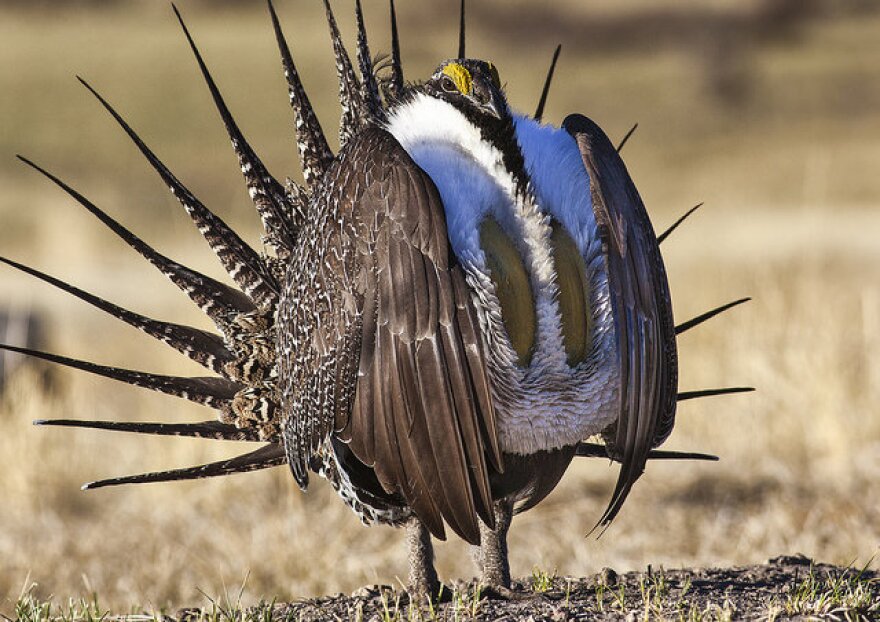Brian Maxfield is a wildlife conservation biologist for the Utah Division of Wildlife Resources. And he's a bit of a voyeur.
Back in the spring, Maxfield strapped transmitters to about a dozen greater sage grouse in northeastern Utah. His goal? To spy on them.
Each bird’s every move is now a mosaic of color-coded dots on a clipboard he keeps in his pickup. Today, he’s honing in on the blue dot. And he’s worried.

“You can see where she hung out up here, that’s where her nest was,” he says, pointing to the map of transmitter readings. “And then, after the chicks were old enough, then she moved down to that big meadow where it’s wetter and there’s a lot more bugs.”
Sage grouse return to the same spots for mating and feeding over and over. So, as wildfire, development and grazing have cut into the landscape, the birds increasingly show up at a favorite spot only to find it no longer suitable.
The meadow where this particular hen brought her chicks happens to be the mating ground where she began her adult life.
For five years, bureaucrats, landowners and wildlife experts have spent hundreds of millions of dollars to protect this mottled-brown species. Some 16 million of the birds once roamed 11 Western states.
But because the sagebrush the bird depends on for food and shelter has declined significantly over the last century, sage grouse numbers have dropped by more than 95 percent. Fire, invasive grasses, energy development and other human activities are to blame.

Later this month, the U.S. Fish and Wildlife Service will decide if sage grouse belong on the Endangered Species List.
The birds mate in areas called leks. Picture a junior high dance floor, says biologist Todd Black. Black manages wildlife for the largest private ranch in Utah.
“The boys want to look the best for the girls, and so they’re in some open area that doesn’t have a lot of brush so the girls can kind of check them out,” says Black. “And what’s really interesting is the majority of hens are going to mate with one to two or three males on that lek.”
When male sage grouse bust a move, they make a distinctive plopping and zipping noise. Their brilliant white chest feathers puff up and two yellowish-green air sacs peek out. Mating season can last from February through May.
“They usually start just before sunrise,” says Brian Maxfield. “The males will fly in. They’ll start strutting.”
Leks can have anywhere from a few males to several hundred. All of them are vying for female attention. And they’re persistent. Maxfield says on a full moon, he’s seen male grouse strut all night.
They can afford to spend the energy, since a sage grouse male’s only job is to mate. The females do the rest.

After the lek, the hen Maxfield is tracking flew to an area with dense sage brush where she could hide from predators and lay her eggs. She’s traveled many miles in search of three distinct landscapes: wide open areas for mating, dense sagebrush for nesting and less-dense brush with easier access to food for her chicks.
Sage grouse are demanding when it comes to habitat – that is why biologists like Randy Larsen at Brigham Young University watch them so closely.
“They represent for the sagebrush ecosystem, which is a huge chunk of western North America, sort of an indicator species as to how healthy those systems are,” Larsen says.
Like the canary in a coal mine, when sage grouse struggle, you can be sure other sagebrush-dependent critters like pygmy rabbits, sage sparrows and sage thrashers are hurting, too.
This is why Maxfield is tracking the blue dot hen with such concern. Her transmitter stopped working about a week ago. The last reading came from this mountain meadow. He climbs out of the pickup and starts wading through the tall grass.
“We’re right on the GPS point,” he mutters, scanning the area for signs of the bird. Then he spots her. “Feathers.”

He points to a breastbone the size of his palm. There’s a wing, too.
“It’s been eaten extensively,” Maxfield says.
Standing up straight, he looks toward the edge of the meadow and says it was probably a hawk that got the grouse. There’s a twinge of regret in his voice.
“When I look at all the dead trees a hawk could sit on, I think we need to come in...that all of these raptor perches should be gone.”
The trees are remnants of a fire that swept through this popular sage grouse habitat a decade ago. Tree removal is expensive. So is fighting wildfires, battling invasive cheat grass and restricting development or mining in sage country. But those who know the bird say an effort of this caliber is the only chance the sage grouse have.
For more local news, follow the KBSX newsroom on Twitter @KBSX915
Copyright 2015 Boise State Public Radio




